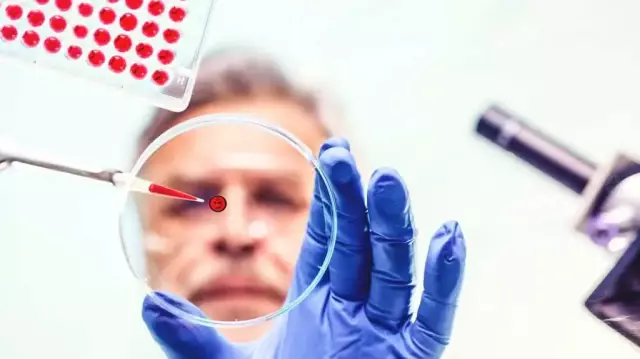- Author Rachel Wainwright [email protected].
- Public 2023-12-15 07:39.
- Last modified 2025-11-02 20:14.
Myxedema
Myxedema is a disease resulting from a decrease or cessation of the flow of thyroid hormones into the blood (hypothyroidism). Myxedema affects people at any age, including children, but women are most susceptible to it during menopausal changes in the body. This category of people suffers from this disease five times more often than others.
Causes of myxedema

Myxedema develops with hypothyroidism, which accompanies thyroid disease or its congenital insufficiency, respectively, the disease is primary and secondary.
Primary myxedema occurs as an independent disease with damage to the thyroid gland. Thyroid function is lost due to inflammation, tumor, autoimmune attack, trauma, including the operating room, after the administration of radioactive iodine in the treatment of hyperthyroidism. Sometimes the cause of myxedema is hypothyroidism due to a lack of iodine in the area of residence (endemic goiter).
The cause of congenital hypothyroidism is most often the infectious intoxication of a woman during pregnancy.
Secondary myxedema is one of the symptoms of brain pathology, namely the hypothalamic-pituitary system.
Symptoms of myxedema
Thyroid hormones affect the functioning of the body as a whole, therefore myxedema is a disease characterized by a multitude of symptoms that are present from all body systems. However, there are characteristic symptoms of myxedema, the combination of which is a diagnostic sign of this disease. These signs include:
- Mucous edema of the skin and subcutaneous tissue. Mucous edema differs from other types of edema in that pressing with a finger does not leave a depression on the skin, as is the case with other types of edema. As a result of edema, the face becomes puffy and mask-like, facial features are rough, bags under the eyes appear;
- Hair is brittle, thin, falls out easily, nails are brittle, exfoliating. This symptom of myxedema is caused by dystrophic changes in the skin and subcutaneous tissue, resulting from mucous edema;
- A rough, hoarse voice, which occurs due to swelling of the vocal cords, due to swelling of the tongue, speech may become slurred, blurry;
As follows from the above, the leading symptoms of myxedema are the result of the same mucous edema.
The rest of the symptoms of myxedema are characteristic of all types of hypothyroidism: frostiness caused by circulatory failure, heart pain, fatigue, drowsiness, decreased general tone, general lethargy and impaired concentration, loss of appetite, constipation. The musculoskeletal system suffers, myalgia (muscle pain), muscle weakness, arthralgia (joint pain), arthrosis appear. There is polyserositis - a combined inflammation of the inner membranes (peritoneum, pericardium, pleura).
Myxedema in childhood is manifested by a delay in physical, mental and sexual development.
Myxedema in children can be congenital or early. The earlier the function of the thyroid gland is disturbed, the more serious consequences the child's health is subject to. Congenital myxedema is manifested by cretinism - a severe disorder of all body systems, the most pronounced of which is growth retardation, deformity due to improper development of the musculoskeletal system, and a significant decrease in intelligence. With early myxedema, the development of the child is suspended from the moment the disease occurs.
Diagnosis of myxedema
The diagnosis of myxedema is made by examining the content of thyroid hormones in the blood, as well as pituitary hormones, which regulate the flow of thyroid hormones into the blood. The thyroid gland is examined using ultrasound and fine-needle aspiration puncture of the thyroid gland and examination of the contents obtained.
Treatment of myxedema
Treatment of myxedema consists in correcting hormonal deficiency by introducing thyroid hormones from the outside. The dosage is calculated individually, the drug containing hormones is taken once a day.
If iodine deficiency is established, iodine preparations and a diet rich in iodine-containing products (seaweed, sea fish and other seafood, walnuts, iodized salt) are prescribed.
The lost functions of the thyroid gland are not restored, so treatment of myxedema should be lifelong.
Myxedema prognosis
The disease is characterized by a slow increase in symptoms, therefore, if it is possible to diagnose and start adequate treatment of myxedema in time, the disease will proceed benignly, although it will have to be treated for life.
As for myxedema in childhood, it is of great importance to recognize the disease as early as possible, which is difficult in practice. With congenital myxedema, the prognosis is poor, with early myxedema, it is possible to significantly improve the patient's condition by carrying out hormone replacement therapy, however, it is usually not possible to completely eliminate the symptoms of myxedema.
Pretibial myxedema

Separately, it is necessary to consider a disease such as pretibial myxedema, or thyroid dermopathy. Unlike classical myxedema, pretibial myxedema occurs not with reduced, but with excessively increased thyroid function, the so-called thyrotoxicosis. The cause of thyrotoxicosis is most often diffuse toxic goiter, popularly known as Graves' disease.
Pretibial myxedema has local manifestations, in contrast to the usual myxedema, which manifests itself diffusely. A symptom of pretibial myxedema is the appearance of modified areas of skin on the lower part of the front surfaces of the legs. The skin in these areas becomes rough, thickens, takes on a red or purple-red color, increased keratinization is noted. On the affected areas of the skin, protruding hair follicles are released, subsequently the hair falls out. The external symptoms of myxedema pretibial are sometimes accompanied by a sensation of severe itching.
Treatment of myxedema pretibial is carried out in combination with the correction of thyroid disorders, which caused the onset of the disease. Local treatment of myxedema in the case when the disease is accompanied by itching consists in the use of ointments containing steroid anti-inflammatory drugs. In most cases, patients with pretibial myxedema are concerned only with a cosmetic defect, and then special treatment of myxedema is not carried out, but the underlying disease is treated.
YouTube video related to the article:
The information is generalized and provided for informational purposes only. At the first sign of illness, see your doctor. Self-medication is hazardous to health!






